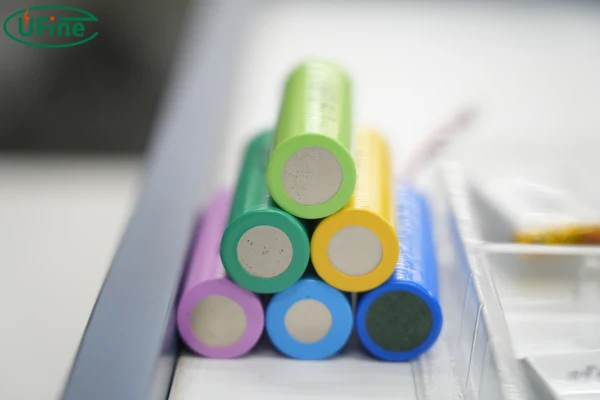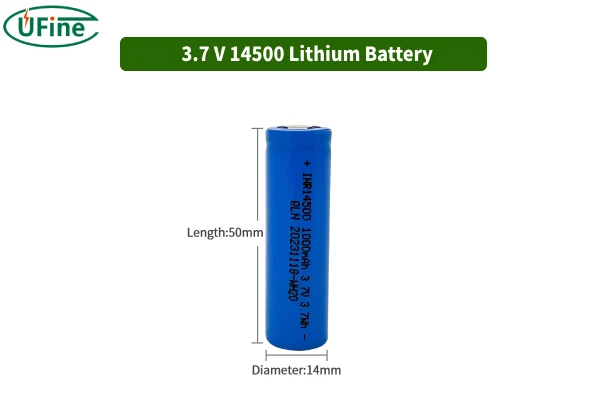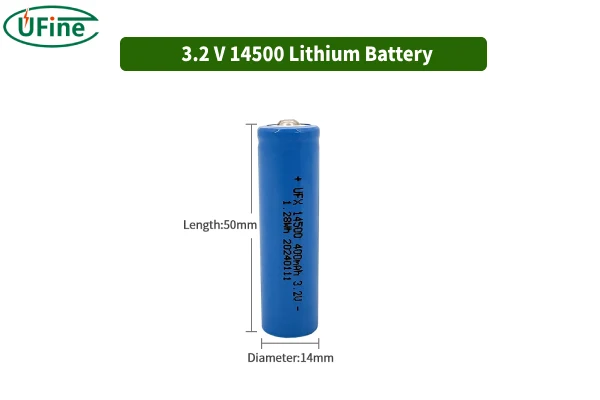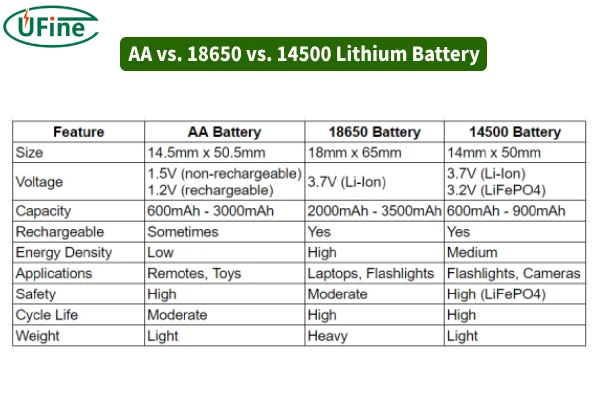Have you ever wondered about those small but powerful batteries in your flashlights or portable devices? If so, you’re likely thinking about the 14500 lithium battery. These batteries pack a punch despite their small size. But what exactly are they, and why are they so popular? Let’s dive into the world of 14500 lithium batteries and uncover everything you need to know.
Part 1. What is the 14500 lithium battery?
A 14500 li-ion battery is a compact, cylindrical lithium-ion rechargeable battery. Its name reflects its dimensions:
- 14 mm diameter
- 50 mm length
This standardized size makes it comparable to AA batteries, but the 14500 stands out with a nominal voltage of 3.7V, significantly higher than the 1.5V of alkaline AA batteries.
Structure and Principle
14500 batteries operate on the principles of lithium-ion technology:
- Anode: Typically made of graphite, this is where lithium ions are stored during charging.
- Cathode: Often composed of lithium cobalt oxide (LiCoO2), lithium manganese oxide (LiMn2O4), or other chemistries.
- Electrolyte: Facilitates the movement of lithium ions between the anode and cathode.
During discharge, lithium ions move from the anode to the cathode, generating energy. The reverse occurs during charging.
Learn About the Cathode and Anode of the Battery
Key Features
- Rechargeable: Environmentally friendly and cost-effective over time.
- High Energy Density: Delivers more power in a smaller package.
- Lightweight: Ideal for portable applications.
- Voltage Stability: Provides consistent power output for sensitive devices.
Part 2. Key parameters of 14500 li-ion batteries
Understanding the specifications of a 14500 rechargeable battery is essential for making an informed purchase. Let’s break down the key parameters:
- Size: 14 mm x 50 mm, the same dimensions as a standard AA battery.
- Nominal Voltage: 3.7V (some models may have 3.6V).
- Charging Voltage: Typically 4.2V.
- Cut-off Voltage: Between 2.5V and 3.0V; discharging below this range can damage the battery.
- Discharge Voltage: Consistently around 3.6V–3.7V during use.
- Chemistry: Common types include lithium cobalt oxide (LCO), lithium manganese oxide (LMO), and lithium iron phosphate (LFP).
- Capacity: Ranges from 600mAh to 1200mAh.
- Cycle Life: Generally lasts for 300–500 charge cycles, depending on usage and quality.
- Protection Circuit: Some batteries include a built-in circuit to prevent overcharging, over-discharging, and overheating.
Part 3. Capacity
Battery capacity, measured in milliampere-hours (mAh), indicates how much energy the battery can store and deliver.
-
- 600–800mAh: Ideal for low-drain devices like small flashlights.
- 1000–1200mAh: Suitable for high-drain devices such as cameras and tools.
How Capacity Affects Performance
A higher capacity means longer runtime but also results in slightly longer charging times. When choosing a battery, consider the device’s energy demands and usage frequency.
Part 4. 3.7V 14500 Li-Ion battery
The 3.7V 14500 Li-Ion battery is a popular choice for many users. These batteries have a high energy density, which means they can store a lot of power in a small package. They also have a relatively long cycle life, meaning they can be recharged many times before their capacity starts to diminish significantly. This makes them an excellent choice for devices that need a reliable and long-lasting power source.
You’ll find 3.7V 14500 Li-Ion batteries in a variety of devices:
- Flashlights: Their high voltage and capacity make them ideal for bright, long-lasting illumination.
- Cameras: They provide the necessary power for high-drain functions like flash and continuous shooting.
- Portable Electronics: Any high-drain device that benefits from a compact power source can use these batteries.
Part 5. 14500 LiFePO4 battery
The 14500 LiFePO4 battery is another type worth discussing. LiFePO4 batteries are known for their exceptional safety and stability. They have a nominal voltage of 3.2V, which is slightly lower than Li-Ion batteries. However, they are much more resistant to overheating and thermal runaway, making them a safer option, especially in high-temperature environments. Additionally, they have a long lifespan, often outlasting their Li-Ion counterparts.
These batteries are used in applications where safety and longevity are paramount:
- Emergency Lighting: Their stability makes them ideal for use in emergency lights that must work reliably under all conditions.Solar Power Systems: They are often used in solar power setups where long life and safety are crucial.
- Electric Vehicles: Smaller electric vehicles like e-bikes and scooters can benefit from the stability and long life of LiFePO4 batteries.
Part 6. AA vs. 18650 vs. 14500 lithium battery
When choosing a battery, it’s helpful to compare different types to understand their strengths and weaknesses. Here’s a detailed comparison of AA, 18650, and 14500 lithium batteries:
- Size: AA and 14500 batteries are similar in size, while 18650 batteries are noticeably larger. This affects their compatibility with different devices.
- Voltage: AA batteries have the lowest voltage, making them suitable for low-drain devices. The 14500 and 18650 batteries have higher voltages, making them better for high-drain applications.
- Capacity: 18650 batteries have the highest capacity, which means they can last the longest per charge. 14500 batteries offer a good balance between size and capacity.
- Rechargeability: While some AA batteries are rechargeable, 14500 and 18650 batteries are almost always rechargeable, making them more cost-effective in the long run.
- Energy Density: 18650 batteries have the highest energy density, followed by 14500 batteries. AA batteries have the lowest energy density.
- Applications: AA batteries are common in low-drain devices like remote controls and toys. 18650 batteries are used in high-drain applications like laptops and powerful flashlights. 14500 batteries are versatile and used in a variety of medium to high-drain devices.
- Safety: LiFePO4 versions of 14500 batteries offer the highest safety, while Li-Ion versions of 18650 batteries require careful handling to prevent overheating.
Part 7. How long does a 14500 lithium battery last?
The lifespan of a 14500 lithium battery can vary based on several factors, including the type of battery, the device it’s used in, and how well it’s maintained. Generally, 14500 lithium batteries can last between 300 to 500 charge cycles. This means you can recharge the battery 300 to 500 times before its capacity drops significantly.
Factors Affecting Lifespan
- Usage: High-drain devices will deplete the battery faster, reducing the number of charge cycles.
- Storage: Storing batteries at high temperatures can reduce their lifespan. It’s best to store them in a cool, dry place.
- Charging: Using a proper charger designed for 14500 batteries can help maintain their health. Overcharging or using a low-quality charger can damage the battery.
Tips for Extending Battery Life
- Avoid Complete Discharge: Try not to let the battery discharge completely before recharging it.
- Use Appropriate Chargers: Always use a charger specifically designed for 14500 lithium batteries.
- Store Properly: If you’re not using the battery for an extended period, store it at around 50% charge in a cool, dry place.
Part 8. How to calculate the charging time of a 14500 battery?
Charging time depends on the battery’s capacity and the charger’s current. Here’s the formula:

For example, an 800mAh battery charged with a 500mA charger will take:
This calculation ensures efficient charging while protecting the battery from overcharging.
Part 9. Charger
To charge a 14500 battery, use a compatible lithium-ion charger. Look for chargers with these features:
- Smart Charging: Automatically stops when the battery is full.
- Voltage Compatibility: Supports 4.2V charging.
- Overcharge Protection: Prevents overheating and damage.
Part 10. How to charge 14500 batteries?
Charging your 14500 battery correctly is vital for safety and performance. Follow these steps:
- Select the Right Charger: Ensure it’s designed for lithium-ion batteries.
- Insert Properly: Match the positive and negative terminals.
- Monitor Charging: Avoid leaving the battery unattended.
- Avoid Extreme Temperatures: Charge in a cool, well-ventilated area.
Part 11. Best 14500 battery
Here are some of the most popular 14500 battery brands to consider:
- Ufine Battery: Renowned for custom lithium solutions.
- Panasonic: High-capacity, reliable performance.
- Samsung: Consistent quality and durability.
- Efest: Ideal for flashlight enthusiasts.
- Nitecore: Excellent protected batteries.
- Keeppower: High-quality and long-lasting.
- XTAR: Affordable yet dependable options.
Related Tags:
More Articles

How to Choose the Best Floor Scrubber Battery for Commercial Cleaning?
Selecting the ideal floor scrubber battery ensures a long runtime, rapid charging, and minimal maintenance for efficient commercial cleaning operations.
Battery for Blower vs Battery for Leaf Vacuum: Which One Should You Choose?
Battery for blower vs leaf vacuum—learn the key differences in power, fit, and runtime to choose the right battery for your outdoor tool needs.
How to Choose the Right Battery for Blower?
Choosing the right blower battery? Consider voltage, capacity, chemistry & usage. This guide helps match the best battery for peak performance.
How to Choose the Best Insulated Battery Box for Lithium Batteries?
Choosing the Best Insulated Battery Box for Lithium Batteries? Discover key factors such as size, material, and safety for optimal protection and performance.
7 Critical Elements on a Lithium Battery Shipping Label
What must be on a lithium battery shipping label? Learn 7 key elements to ensure safety, legal compliance, and correct handling across all transport modes.








